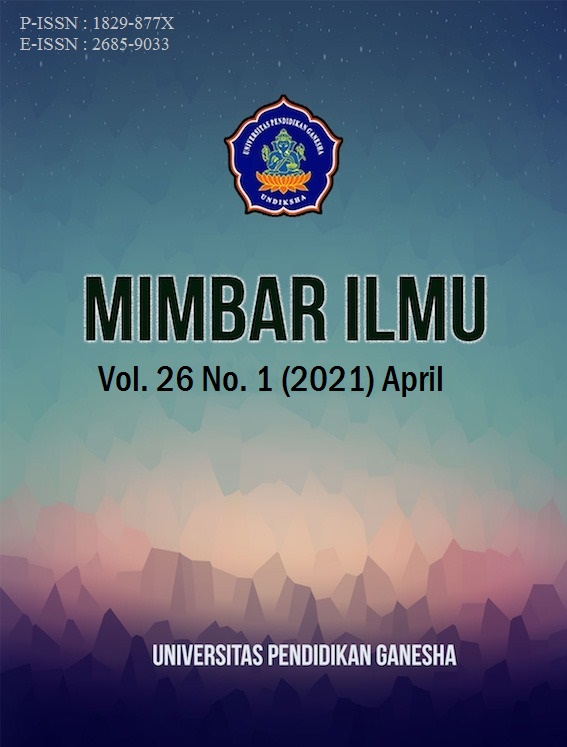Problem Based Learning with ICT Based with Learning Creativity to Improve History Learning Achievement
DOI:
https://doi.org/10.23887/mi.v26i1.31486Abstract
Proses pembelajaran yang membosankan membuat partisipasi siswa dalam kegiatan belajar di kelas kurang antusias sehingga dapat membuat prestasi belajar siswa menurun. Tujuan utama penelitian ini adalah untuk menganalisis pengaruh model pembelajaran berbasis masalah TIK dengan kreativitas siswa terhadap prestasi belajar sejarah. Penelitian ini merupakan penelitian eksperimental semu dengan desain faktorial. Sampel penelitian ini adalah XI - IPA 1, XI - IPA 2, XI - IPA 3, dan XI - IPA 5 yang masing-masing kelas terdiri dari 34 siswa dan total 170 siswa. Instrumen yang digunakan adalah tes hasil belajar berupa soal pilihan ganda dan tes kreativitas berupa soal uraian. Data pada penelitian ini dianalisis menggunakan statistik inferensial dengan Two Way Anova. Hasil penelitian ini diperoleh F-hitung = 28,908 dengan nilai signifikansi 0,000 kurang dari 0,05, diperoleh F-hitung = 4,623 dengan nilai signifikansi 0,033 lebih kecil dari 0,05, diperoleh F-hitung = 6,060 dengan a nilai signifikansi 0,015 lebih kecil dari 0,05. Dari hasil penelitian ini dapat diimplikasikan untuk meningkatkan prestasi belajar sejarah, model pembelajaran berbasis masalah dapat digunakan sebagai model alternatif untuk menciptakan lingkungan belajar yang interaktif.
References
Arrosagaray, M., González-Peiteado, M., Pino-Juste, M., & Rodríguez-López, B. (2019). A comparative study of Spanish adult students’ attitudes to ICT in classroom, blended and distance language learning modes. Computers and Education, 134(October 2018), 31–40. https://doi.org/10.1016/j.compedu.2019.01.016
Athanases, S. Z., Sanchez, S. L., & Martin, L. M. (2020). Saturate, situate, synthesize: Fostering preservice teachers’ conceptual and practical knowledge for learning to lead class discussion. Teaching and Teacher Education, 88, 102970. https://doi.org/10.1016/j.tate.2019.102970
Dwi, I. M., Arif, H., & Sentot, K. (2013). Pengaruh strategi problem based learning berbasis ICT terhadap pemahaman konsep dan kemampuan pemecahan masalah fisika. Jurnal Pendidikan Fisika Indonesia, 9(1), 8–17. https://doi.org/10.15294/jpfi.v9i1.2575
Fernández-Gutiérrez, M., Gimenez, G., & Calero, J. (2020). Is the use of ICT in education leading to higher student outcomes? Analysis from the Spanish Autonomous Communities. Computers and Education, 157, 103969. https://doi.org/10.1016/j.compedu.2020.103969
Gil-Flores, J., Rodríguez-Santero, J., & Torres-Gordillo, J. J. (2017). Factors that explain the use of ICT in secondary-education classrooms: The role of teacher characteristics and school infrastructure. Computers in Human Behavior, 68, 441–449. https://doi.org/10.1016/j.chb.2016.11.057
Gunantara, G., Suarjana, M., & Riastini, P. N. (2014). Penerapan model pembelajaran problem based learning untuk meningkatkan kemampuan pemecahan masalah matematika siswa kelas V. Jurnal Mimbar PGSD Undiiksha, 2(1). https://doi.org/http://dx.doi.org/10.23887/jjpgsd.v2i1.2058
Gunawan, G., Sahidu, H., Harjono, A., & Suranti, N. M. Y. (2017). The effect of project based learning with virtual media assistance on student’s creativity in physics. Jurnal Cakrawala Pendidikan, 2. https://journal.uny.ac.id/index.php/cp/article/view/13514/pdf
Hasibuan, N. (2015). Pengembangan pendidikan Islam dengan implikasi teknologi Pp. FITRAH:Jurnal Kajian Ilmu-Ilmu Keislaman, 1(2). https://doi.org/10.24952/fitrah.v1i2.313
Kristinawati, E., Susilo, H., & Gofur, A. (2018). ICT Based-Problem Based Learning on Students’ Cognitive Learning Outcomes. Jurnal Pendidikan Sains, 6(2), 38–42. https://doi.org/http://dx.doi.org/10.17977/jps.v6i2.11683
Listiani, N. M. (2014). Pengaruh kreativitas dan motivasi terhadap hasil belajar mata pelajaran produktif pemasaran pada siswa kelas XI SMK Negeri 2 Tuban. Jurnal Ekonomi Pendidikan Dan Kewirausahaan, 2(2). https://doi.org/10.1017/CBO9781107415324.004
Mutakinati, L., Anwari, I., & Yoshisuke, K. (2018). Analysis of students’ critical thinking skill of middle school through stem education project-based learning. Jurnal Pendidikan IPA Indonesia, 7(1), 54–65. https://doi.org/10.15294/jpii.v7i1.10495
Ngalimun. (2017). Strategi Pembelajaran dilengkapi dengan 65 Model Pembelajaran. Parama Ilmu.
Nursamsu, N., & Kusnafizal, T. (2017). Pemanfaatan Media Pembelajaran Ict Sebagai Kegiatan Pembelajaran Siswa Di Smp Negeri Aceh Tamiang. Jurnal IPA & Pembelajaran IPA, 1(2), 165–170. https://doi.org/10.24815/jipi.v1i2.9691
Nuswowati, M., Susilaningsih, E., Ramlawati, & Kadarwati, S. (2017). Implementation of problem-based learning with green chemistry vision to improve creative thinking skill and students’ creative actions. Jurnal Pendidikan IPA Indonesia, 6(2), 221–228. https://doi.org/10.15294/jpii.v6i2.9467
Rahayu, E., & Fahmi, S. (2018). Efektivitas penggunaan model problem based Learning (PBL) dan inkuiri terhadap hasil belajar matematika siswa SMP N 1 Kasihan Kabupaten Bantul semester genap tahun ajaran 2017/2018. JURING (Journal for Research in Mathematics Learning), 1(2), 147. https://doi.org/10.24014/juring.v1i2.5671
Rohana, R., & Wahyudin, D. (2017). Project based learning untuk meningkatkan berpikir kreatif siswa SD pada materi makanan dan kesehatan. Jurnal Penelitian Pendidikan, 16(3), 235–243. https://ejournal.upi.edu/index.php/JER/article/view/4817
Roling, G., Lutz, G., Edelhäuser, F., Hofmann, M., Valk-Draad, M. P., Wack, C., Haramati, A., Tauschel, D., & Scheffer, C. (2020). Empathy, well-being and stressful experiences in the clinical learning environment. Patient Education and Counseling, 2019. https://doi.org/10.1016/j.pec.2020.04.025
Sa’diyah, S. (2020). Peningkatan motivasi dan hasil belajar sistem gerak melalui model pembelajaran problem based learning. Journal of Curriculum Indonesia, 3(2), 79. https://doi.org/10.46680/jci.v3i2.32
Sedgwick, & Philip. (2014). Statistical Question- Cluster Sampling. Article BMJ. https://doi.org/10.1136/bmj.g1215.
Seng, & Hill. (2014). Using a Dialogical Approach to examine Peer feedback During Chemidtry Investigative Task Discussion. Res Science Education, 44, 727–749.
Serevina, & Dkk. (2018). Development of E-module Based on Problem Based Learning (PBL) on Heat and Temperature to Improve Student’s Science Process Skill”. Journal of Educational Technology, 17(3), 26–36.
Suprapto, P. K., bin Ahmad, M. Z., Chaidir, D. M., Ardiansyah, R., & Diella, D. (2018). Spatial intelligence and students’ achievement to support creativity on visuospatial-based learning. Jurnal Pendidikan IPA Indonesia, 7(2), 224–231. https://doi.org/10.15294/jpii.v7i2.14322
Suryawati, E., Suzanti, F., Zulfarina, Putriana, A. R., & Febrianti, L. (2020). The implementation of local environmental problem-based learning student worksheets to strengthen environmental literacy. Jurnal Pendidikan IPA Indonesia, 9(2), 169–178. https://doi.org/10.15294/jpii.v9i2.22892
Suwasono, & Puspitasari, E. (2016). Pengaruh Problem Based Learning Berbantuan ICT terhadap Kemampuan Pemecahan Masalah Mahasiswa Pendidikan Fisika Angkatan Tahun 2016/2017 pada Materi Fluida Statis. Jurnal Riset Pendidikan Fisika, 1(1), 28–32.
Wu, T. T., & Wu, Y. T. (2020). Applying project-based learning and SCAMPER teaching strategies in engineering education to explore the influence of creativity on cognition, personal motivation, and personality traits. Thinking Skills and Creativity, 35(January), 100631. https://doi.org/10.1016/j.tsc.2020.100631
Yassin, S. F. (2010). Interdiscipinary Intergration Trough Problem Based Learning With ICT in Pre-Service Teacher Education. Proceedings of EABR Dan ETLC Converence, Dublin, Ireland, 377–385.
Zahroa, Sumardi, & Marjono. (2017). The Implementation Of The Character Education In History Teaching. Jurnal Historica, 1(1), 1–11.
Downloads
Published
How to Cite
Issue
Section
License
This work is licensed under a Creative Commons Attribution-ShareAlike 4.0 International License.
Authors who publish with this journal agree to the following terms:
- Authors retain copyright and grant the journal right of first publication with the work simultaneously licensed under a Creative Commons Attribution-ShareAlike 4.0 International License that allows others to share the work with an acknowledgment of the work's authorship and initial publication in this journal.
- Authors are able to enter into separate, additional contractual arrangements for the non-exclusive distribution of the journal's published version of the work (e.g., post it to an institutional repository or publish it in a book), with an acknowledgment of its initial publication in this journal.
- Authors are permitted and encouraged to post their work online (e.g., in institutional repositories or on their website) prior to and during the submission process, as it can lead to productive exchanges, as well as earlier and greater citation of published work.





